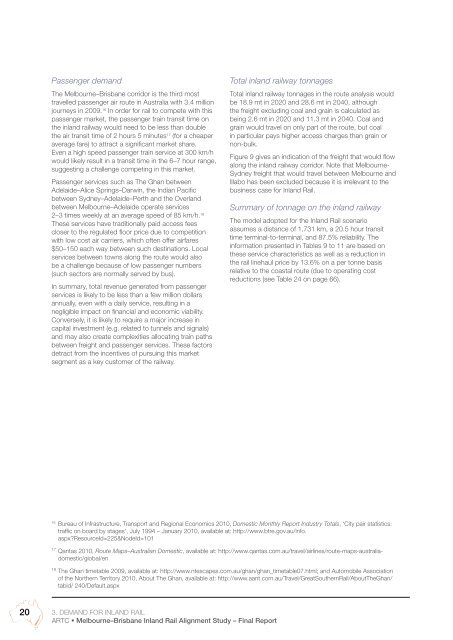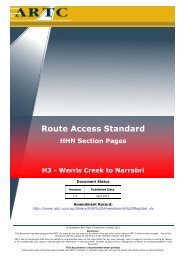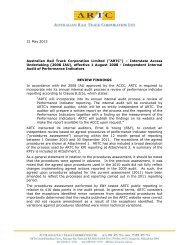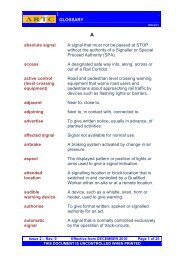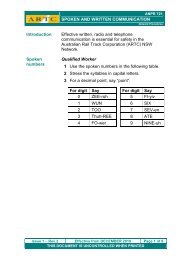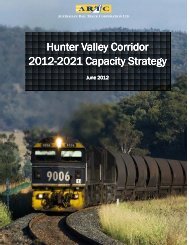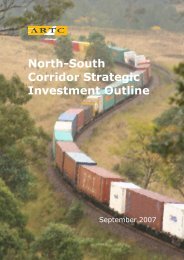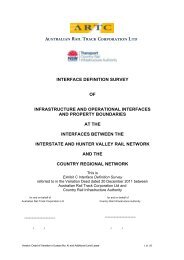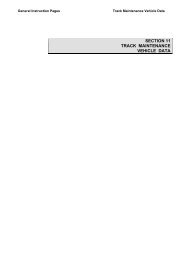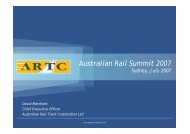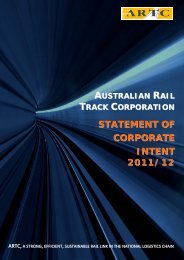MelbourneâBrisbane Inland Rail Alignment Study - Australian Rail ...
MelbourneâBrisbane Inland Rail Alignment Study - Australian Rail ...
MelbourneâBrisbane Inland Rail Alignment Study - Australian Rail ...
Create successful ePaper yourself
Turn your PDF publications into a flip-book with our unique Google optimized e-Paper software.
Passenger demand<br />
The Melbourne–Brisbane corridor is the third most<br />
travelled passenger air route in Australia with 3.4 million<br />
journeys in 2009. 16 In order for rail to compete with this<br />
passenger market, the passenger train transit time on<br />
the inland railway would need to be less than double<br />
the air transit time of 2 hours 5 minutes 17 (for a cheaper<br />
average fare) to attract a significant market share.<br />
Even a high speed passenger train service at 300 km/h<br />
would likely result in a transit time in the 6–7 hour range,<br />
suggesting a challenge competing in this market.<br />
Passenger services such as The Ghan between<br />
Adelaide–Alice Springs–Darwin, the Indian Pacific<br />
between Sydney–Adelaide–Perth and the Overland<br />
between Melbourne–Adelaide operate services<br />
2–3 times weekly at an average speed of 85 km/h. 18<br />
These services have traditionally paid access fees<br />
closer to the regulated floor price due to competition<br />
with low cost air carriers, which often offer airfares<br />
$50–150 each way between such destinations. Local<br />
services between towns along the route would also<br />
be a challenge because of low passenger numbers<br />
(such sectors are normally served by bus).<br />
In summary, total revenue generated from passenger<br />
services is likely to be less than a few million dollars<br />
annually, even with a daily service, resulting in a<br />
negligible impact on financial and economic viability.<br />
Conversely, it is likely to require a major increase in<br />
capital investment (e.g. related to tunnels and signals)<br />
and may also create complexities allocating train paths<br />
between freight and passenger services. These factors<br />
detract from the incentives of pursuing this market<br />
segment as a key customer of the railway.<br />
Total inland railway tonnages<br />
Total inland railway tonnages in the route analysis would<br />
be 18.9 mt in 2020 and 28.6 mt in 2040, although<br />
the freight excluding coal and grain is calculated as<br />
being 2.6 mt in 2020 and 11.3 mt in 2040. Coal and<br />
grain would travel on only part of the route, but coal<br />
in particular pays higher access charges than grain or<br />
non-bulk.<br />
Figure 9 gives an indication of the freight that would flow<br />
along the inland railway corridor. Note that Melbourne-<br />
Sydney freight that would travel between Melbourne and<br />
Illabo has been excluded because it is irrelevant to the<br />
business case for <strong>Inland</strong> <strong>Rail</strong>.<br />
Summary of tonnage on the inland railway<br />
The model adopted for the <strong>Inland</strong> <strong>Rail</strong> scenario<br />
assumes a distance of 1,731 km, a 20.5 hour transit<br />
time terminal-to-terminal, and 87.5% reliability. The<br />
information presented in Tables 9 to 11 are based on<br />
these service characteristics as well as a reduction in<br />
the rail linehaul price by 13.6% on a per tonne basis<br />
relative to the coastal route (due to operating cost<br />
reductions (see Table 24 on page 66).<br />
16<br />
Bureau of Infrastructure, Transport and Regional Economics 2010, Domestic Monthly Report Industry Totals, ‘City pair statistics:<br />
traffic on board by stages’, July 1994 – January 2010, available at: http://www.btre.gov.au/info.<br />
aspx?ResourceId=225&NodeId=101<br />
17<br />
Qantas 2010, Route Maps–<strong>Australian</strong> Domestic, available at: http://www.qantas.com.au/travel/airlines/route-maps-australiadomestic/global/en<br />
18<br />
The Ghan timetable 2009, available at: http://www.ntescapes.com.au/ghan/ghan_timetable07.html; and Automobile Association<br />
of the Northern Territory 2010, About The Ghan, available at: http://www.aant.com.au/Travel/GreatSouthern<strong>Rail</strong>/AboutTheGhan/<br />
tabid/ 240/Default.aspx<br />
20<br />
3. Demand for <strong>Inland</strong> <strong>Rail</strong><br />
ARTC • Melbourne–Brisbane <strong>Inland</strong> <strong>Rail</strong> <strong>Alignment</strong> <strong>Study</strong> – Final Report


